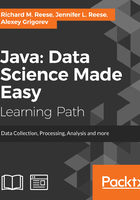
Data Visualization
The human mind is often good at seeing patterns, trends, and outliers in visual representations. The large amount of data present in many data science problems can be analyzed using visualization techniques. Visualization is appropriate for a wide range of audiences, ranging from analysts, to upper-level management, to clientele. In this chapter, we present various visualization techniques and demonstrate how they are supported in Java.
In this chapter, we will illustrate how to create different types of graph, plot, and chart. The majority of the examples use JavaFX, with a few using a free library called GRAphing Library (GRAL). There are several open source Java plotting libraries available. A brief comparison of several of these libraries can be found at https://github.com/eseifert/gral/wiki/comparison. We chose JavaFX because it is packaged as part of Java SE.
GRAL is used to illustrate plots that are not as easily created using JavaFX. GRAL is a free Java library useful for creating a variety of charts and graphs. This graphing library provides flexibility in types of plots, axis formatting, and export options. GRAL resources (http://trac.erichseifert.de/gral/) include example code and helpful how to sections.
Visualization is an important step in data analysis because it allows us to conceive of large datasets in practical and meaningful ways. We can look at small datasets of values and perhaps draw conclusions from the patterns we see, but this is an overwhelming and unreliable process. Using visualization tools helps us identify potential problems or unexpected data results, as well as construct meaningful interpretations of good data.
One example of the usefulness of data visualization comes with the presence of outliers. Visualizing data allows us to quickly see data results significantly outside of our expectations, and we can choose how to modify the data to build a clean and usable dataset. This process allows us to see errors quickly and deal with them before they become a problem later on. Additionally, visualization allows us to easily classify information and help analysts organize their inquiries in a manner best suited to their particular dataset.